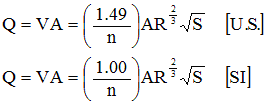Manning's Equation |
One the most commonly used equations governing Open Channel Flow is known as the Mannings’s Equation. It was introduced by the Irish Engineer Robert Manning in 1889 as an alternative to the Chezy Equation. The Mannings equation is an empirical equation that applies to uniform flow in open channels and is a function of the channel velocity, flow area and channel slope.
 Click
here to view an interactive demo of Manning's Equation
Click
here to view an interactive demo of Manning's Equation
Manning’s Equation:

Where:
Q = Flow Rate, (ft3/s)
v = Velocity, (ft/s)
A = Flow Area, (ft2)
n = Manning’s Roughness Coefficient
R = Hydraulic Radius, (ft)
S = Channel Slope, (ft/ft)
Under the assumption of uniform flow conditions the bottom slope is the same as the slope of the energy grade line and the water surface slope. The Manning’s n is a coefficient which represents the roughness or friction applied to the flow by the channel. Manning’s n-values are often selected from tables, but can be back calculated from field measurements. In many flow conditions the selection of a Manning’s roughness coefficient can greatly affect computational results.
Note: Manning’s Equation can be rearranged to solve for slope (S), which is termed the friction slope, (Sf). The friction slope is part of the gradually varied flow used to solve for the water surface profile through a culvert.